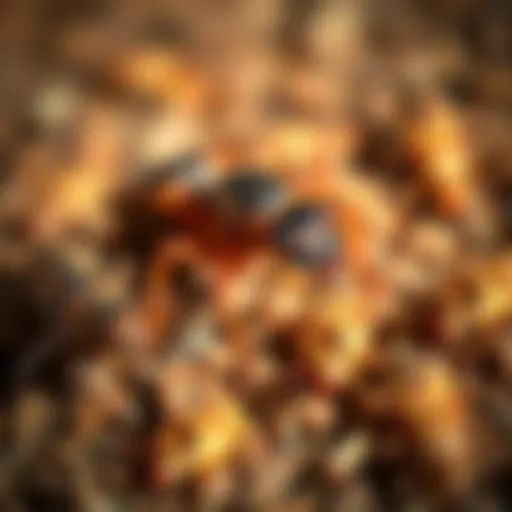Effective Interior Ant Control: Best Practices & Products
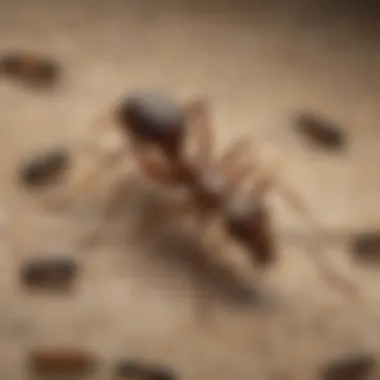

Intro
Ant infestations are a common issue faced by many homeowners. They can invade kitchens, pantries, and even living spaces, creating both a nuisance and potential health concerns. Understanding which type of ants you are dealing with and how to manage them effectively is crucial. This guide explores the best practices and products for interior ant control. Through this comprehensive examination, homeowners can make informed decisions to eradicate these pests while also considering eco-friendly options.
Understanding the Pest
Identification
Identifying the specific ant species present in your home is the erste important step in managing an infestation. Common species include the carpenter ant, known for making nests in wood, and the odorless house ant, which is often attracted to food sources. These ants vary in color, size, and behavior. For example, carpenter ants are larger, while thief ants tend to be smaller and yellowish. Observing the trails ants leave can provide insight into their species and movement patterns, aiding in effective treatment.
Life Cycle
The life cycle of ants consists of four stages: egg, larva, pupa, and adult. The queen lays eggs, which then hatch into larvae. Larvae require feeding and care before they pupate. This cycle can span from weeks to several months, depending on species and environmental factors. Understanding this cycle helps to determine the optimal time for control measures, as targeting ants during their most vulnerable stages can enhance effectiveness.
Pest Prevention Strategies
Environment Modification
A clean and organized home is essential for preventing ants. Reducing clutter and ensuring food is stored properly can deter these pests. Pay attention to the areas around sinks, counters, and trash cans; these spots often attract ants. Regularly cleaning these areas can minimize food sources. Sealing cracks and crevices in walls and foundations also reduces entry points for ants.
Physical Barriers
Creating physical barriers is another effective method. Using products like double-sided tape along known trails can capture ants as they attempt to cross. Additionally, placing diatomaceous earth around entry points can act as a deterrent while remaining safe for your family and pets. These barriers serve as both a temporary solution and a long-term strategy in your pest control efforts.
Control Methods
Chemical Control
Chemical control products are often divided into baits and sprays. Boric acid is a popular choice, known for its effectiveness against various ant species. It disrupts the digestive systems of ants when consumed. In contrast, sprays can provide immediate relief but may not eliminate the entire colony. Using these treatments strategically can enhance results.
Biological Control
Biological control methods focus on using natural predators to manage ant populations. Introducing nematodes or certain parasitic species can help reduce ant numbers in a non-toxic way. This method is increasingly favored by environmentally conscious homeowners. It emphasizes a holistic approach while effectively managing pest populations.
To succeed in ant management, combining various methods offers the best chance for long-term effectiveness.
Understanding the behavior and habits of ants, along with employing prevention and control strategies, can greatly aid in keeping your living space ant-free. By staying informed and proactive, homeowners can tackle infestations before they escalate, ensuring a comfortable environment.
Understanding Ant Infestations
Understanding ant infestations is crucial for effective pest management in the home. Knowledge about these pests facilitates timely interventions, minimizing damage and health risks associated with infestations. Different ant species exhibit distinct behaviors and nesting patterns that influence their control methods. Effective control begins by recognizing the species, as each may require specific strategies.
Biology of Common Indoor Ant Species
Understanding the biology of common indoor ant species equips homeowners with the insights needed for efficient control. Each species has unique characteristics that determine its nesting habits and foraging behavior.
Carpenter Ants
Carpenter ants primarily inhabit wood structures, making them a major concern for homeowners. They do not consume wood but excavate it to create nests. Their ability to cause structural damage makes early detection vital.
A key characteristic of carpenter ants is their size; these ants are typically larger than most others, measuring up to 0.5 inches in length. Their presence can indicate a moisture issue in wooden structures, which poses a potential risk for more serious decay. Inspecting wooden elements in the home can help in early identification.
Odorous House Ants
Odorous house ants are known for their distinctive smell, resembling rotten coconuts when crushed. This odor serves as a trait that can aid in identification during an infestation. They are quite small, about 1/8 inch long, and tend to form large colonies.
This species often invades homes in search of food, especially sugary substances. Their nests are typically found in wall voids or beneath flooring. Being aware of their tendencies allows for targeted control measures.
Pavement Ants
Pavement ants are commonly found nesting beneath sidewalks, stones, and patios. Their small size makes them less noticeable, measuring roughly 1/8 inch in length. They are often mistaken for other small ant species.
One of the significant features of pavement ants is their ability to swarm during certain seasons. They can invade homes searching for food, particularly grease and protein sources. Knowledge of their foraging patterns is essential for effective bait placement.
Argentine Ants
Argentine ants are highly invasive and can form supercolonies. They are dark brown and can measure around 1/8 inch. Their ability to adapt to various environments contributes to their rapid spread, making them a troublesome species.
A unique feature of Argentine ants is their aggressive foraging. They tend to overwhelm local ant populations, which can complicate control measures. Understanding their aggressive nature helps in strategizing pest management approaches.
Ant Behavior and Nesting Habits
Exploring ant behavior, including colony structure and nesting habits, is essential for understanding their infestations.
Colony Structure
The colony structure of ants plays a crucial role in their survival. Ant colonies can vary in size, with some having thousands of workers. Each colony operates around a queen, which is essential for reproduction.
This social structure is beneficial because it enables efficient foraging and resource management. However, large colonies can also make infestations harder to control. Recognizing the complexity of these colonies can guide effective pest control measures.
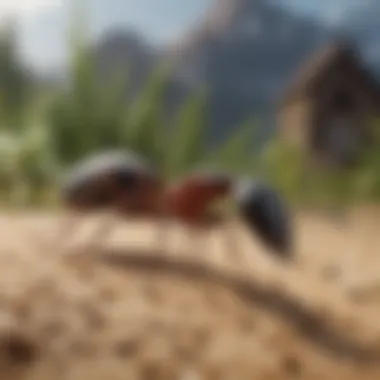

Foraging Patterns
The foraging patterns of ants can differ significantly among species. Some ants prefer to travel short distances, while others maintain established trails over vast areas. Identifying these trails can help in pinpointing infestation sources.
Foraging behavior also impacts food source targeting. Many ants are opportunistic feeders, seeking sugary and greasy foods. By understanding these patterns, homeowners can implement more focused prevention strategies.
Reproductive Cycles
The reproductive cycles of ants greatly influence their population dynamics. During warm months, most ant species experience a significant increase in reproductive activity. Knowing when a species reproduces helps in scheduling treatments effectively.
This aspect of ant biology is vital, as preventing new colonies from establishing can substantially reduce the severity of an infestation. Awareness of reproductive cycles can lead to more informed pest management practices.
Signs of Infestation
Recognizing early signs of ant infestation is crucial for effective control. Once ants settle in a space, they can quickly establish large colonies, making eradication more difficult. Being vigilant allows homeowners to act sooner, which can save time and money. Understanding the various indicators of infestation prepares individuals to take appropriate action before the issue escalates.
Identifying Ant Trails
One of the most distinctive signs of ant activity is the presence of trails. These trails often consist of pheromones that ants leave behind to guide other members of their colony to food sources. Observing these trails can significantly aid in identifying where the ants are entering the home and where they may be traveling. Look for small lines of ants moving in a consistent direction. Often, these trails can lead to gaps or cracks in walls, floors, or even loose window screens. Noting these pathways assists in determining the best locations for applying deterrents or traps.
Common Hiding Spots
Ants prefer to nest in areas that are somewhat undisturbed and near food sources. Common hiding spots include:
- Behind Appliances: Many ants settle behind refrigerators or ovens, where food crumbs often accumulate.
- In Wall Voids: Spaces within walls offer nesting locations that are protected from human interference.
- Under Sink Cabinets: The consistent moisture under sinks attracts certain species like Carpenter ants.
Identifying these areas is essential. Taking preventive measures to limit access or eliminate potential nesting sites will proactively address any developing infestations before they become severe.
Determining the Severity of Infestation
Assessing the severity of an ant problem requires careful observation. Key factors include the number of trails observed, the size of the ant colony, and the frequency of sightings. Here are some signs to consider in your evaluation:
- Number of Ants: A few ants might indicate an early stage, while large clusters suggest an established colony.
- Feeding Sites: If various food sources show signs of ant feeding, the infestation is likely more extensive.
- Nesting Behaviors: Observing ants carrying food back to their nests can indicate they are feeding and reproducing.
It is important to act based on this assessment. If the infestation appears serious, integrated pest management strategies may be necessary to effectively deal with the issue.
Preventive Measures
Preventive measures are essential for effective interior ant control. Addressing potential issues before they escalate can save time, effort, and money. Understanding how ants invade a space leads to strategies that significantly decrease the likelihood of infestations. By being proactive rather than reactive, homeowners can maintain a clean and ant-free environment with less reliance on chemical treatments.
Sealing Entry Points
Identifying and sealing entry points is critical in preventing ant infestations. Ants are small and can squeeze through even the tiniest gaps. Common entry points include cracks in walls, openings around pipes, and gaps in windows and doors. A thorough inspection of the home is necessary to locate these vulnerabilities. After detecting potential entry sites, caulk, weather stripping, or other suitable materials can be used to seal them effectively.
Moreover, focusing on doors and windows is particularly important since these areas are often overlooked yet highly susceptible to ant invasion. Regular maintenance of such seals is vital; deteriorating materials should be repaired promptly to ensure continued protection against future infestations.
Proper Food Storage Techniques
Proper food storage is a fundamental aspect of ant prevention. Ants are attracted to various foods, from sugary items to pet kibble. Storing food in airtight containers reduces its accessibility and makes it less appealing to ants. Glass or hard plastic containers are excellent choices for keeping food safe.
In addition, it is essential to be vigilant about crumbs and spills. Regular cleaning of areas where food is prepared or consumed will limit the chances of attracting ants. Additionally, the use of garbage cans with tight-fitting lids can contain odors that might otherwise draw ants. By changing habits around food, the risk of infestation decreases significantly.
Maintaining Cleanliness
Maintaining a high standard of cleanliness is one of the best preventive measures against ants. A cluttered home provides shelter and pathways for ants, enabling them to navigate to food sources with ease. Regular cleaning routines should focus on surfaces where food is prepared and eaten.
This includes:
- Wiping down countertops and tables after meals
- Vacuuming regularly to remove crumbs and debris
- Cleaning under appliances where food particles can accumulate
In addition to these practices, it is important to also check for leaks or excess moisture. Ants often seek water, which can attract them and encourage nests nearby.
By adopting these practices, homeowners can significantly mitigate the risk of ant infestations in their homes.
Remember, an ounce of prevention is worth a pound of cure. Keeping your space uninviting for ants can be the difference between a pest-free home and a troublesome infestation.
Evaluating Ant Killers
Evaluating ant killers is a critical aspect of managing ant infestations within homes. With many options available in the market, homeowners must make informed decisions to ensure effective and safe treatments. This section highlights the significance of choosing the right ant killer, focusing on how different products cater to specific needs, the safety considerations for household use, and the long-term effectiveness of various solutions.
Chemical Ant Killers
Chemical ant killers have long dominated the pest control industry. These products typically contain active ingredients designed to eliminate ants quickly upon contact or ingestion. For many, chemical solutions offer the advantage of immediate results, which is often what people seek in the face of an infestation.
Some common chemical ant killers include:
- Pyrethroids: Synthetic compounds resembling natural insecticides derived from chrysanthemum flowers. They work by attacking the nervous system of ants.
- Insect growth regulators (IGRs): These disrupt the normal development of ant populations, preventing them from maturing and reproducing.
While efficient, it is crucial to be aware of potential drawbacks. Many chemical ant killers may pose risks to pets and young children. Furthermore, misuse or over-application can lead to chemical resistance within ant populations. Therefore, it’s advisable to follow manufacturer instructions carefully and to consider the long-term implications of using chemical products.
Natural Ant Killers
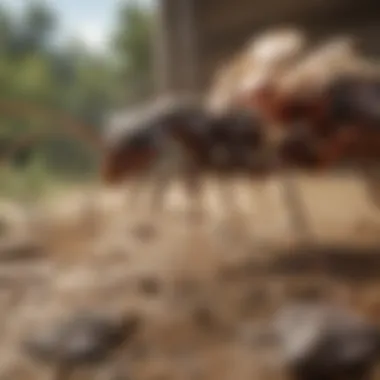

Natural solutions have gained popularity, largely due to increasing environmental awareness. Many homeowners prefer to use ant killers that do not contain harsh chemicals. These eco-friendly options can effectively target ants without endangering other household inhabitants or the ecosystem. Natural ant killers often rely on:
- Diatomaceous Earth (DE): A natural, non-toxic powder that damages ants' exoskeletons, leading to dehydration and death.
- Essential oils: Substances like peppermint or tea tree oil can repel ants or act as effective killers when applied directly.
Natural ant killers typically require more time to show results compared to their chemical counterparts. Nonetheless, they provide a safer alternative for homes with children or pets. Understanding each natural substance's efficacy is essential for choosing the right option.
Comparison of Product Efficacy
When evaluating ant killers, it is important to compare their effectiveness based on specific factors. Each product performs differently against various ant species, the severity of infestation, and application methods. Below are some key considerations:
- Speed of Action: Chemical methods tend to show faster results. Natural methods may take longer to affect ant populations.
- Target Species: Different ant species might respond better to certain products. For instance, Argentine ants are known to be more susceptible to specific IGRs.
- Environmental Impact: Products labeled as natural usually have a lower environmental impact, catering to eco-conscious consumers.
Choosing the right product often requires weighing the urgency of the situation against long-term sustainability goals. Logging user experiences or looking for case studies can also provide valuable insights into efficacy and safety.
When selecting ant control methods, consider both immediate results and long-term consequences to establish an effective pest management strategy.
The process does not end at product choice; it is similar to forming a plan that involves careful application and ongoing management. This comprehensive evaluation is essential to effectively control ant populations and maintain a comfortable living environment.
Top Recommended Products
Ant control products are essential for addressing indoor ant infestations. Each product serves specific needs and works best in various situations. By choosing the right products, homeowners can effectively manage ant problems while minimizing risks. Below, we explore the recommended solutions based on effectiveness, ease of use, and safety considerations.
Ant Baits and Traps
Gel Baits
Gel baits are a favored choice for controlling ant populations. They contain attractants combined with slow-acting insecticides. This allows ants to consume the bait and carry it back to their colony, ultimately affecting more ants. The key characteristic of gel baits is their ease of placement and ability to remain effective over time. They are beneficial, as they can target colonies without requiring extensive treatment across an area.
A unique feature of gel baits is their transparent formulation, which allows homeowners to see when they need to be replaced. Despite their advantages, they may require some patience as they do not provide immediate results.
Granular Baits
Granular baits are another trusted option for indoor ant control. These baits are formulated as small granules that attract ants, leading them to consume the bait before returning to their nest. The key characteristic of granular baits is their versatility; they can be used outdoors and indoors on various surfaces. This makes them a valuable choice for households with varying ant types.
A unique feature of granular baits is their long shelf life, allowing users to keep them on hand for unexpected infestations. However, they may be less effective in areas with high moisture, as they can clump together and lose their attractiveness to ants.
Liquid Insecticides
Residual Sprays
Residual sprays are a popular choice for targeted ant control. These products leave a long-lasting residue that continues to kill ants that come into contact with the treated surfaces. The key characteristic of residual sprays is their effectiveness at creating a barrier against ants. This makes them beneficial in preventing re-infestation in treated areas.
A significant advantage of residual sprays is their fast-acting nature. Household members may notice results within hours. However, caution is advised, as these products contain chemicals that may pose risks to pets and children if misapplied.
Foams
Foams are an innovative option offering targeted application to hard-to-reach areas. They expand on contact and provide a thorough coverage of surfaces. The key characteristic of foams is their capability to penetrate cracks and crevices, where ants often hide. This makes foams a beneficial choice for thorough control.
Foams also have the advantage of easy application. Users can aim and spray where needed. However, like residual sprays, they can contain potent chemicals, requiring attention to safety during usage.
Eco-Friendly Solutions
Diatomaceous Earth
Diatomaceous Earth is a natural pest control solution made from tiny fossilized aquatic organisms. It works by dehydrating ants upon contact, leading to their demise. The key characteristic of Diatomaceous Earth is its non-toxic nature, making it a favorite among environmentally conscious homeowners.
One unique feature is its usability both indoors and outdoors. It is effective in various conditions, although it must remain dry to work optimally. On the downside, its effectiveness can reduce in wet or humid environments, which may limit its application in certain conditions.
Essential Oil Sprays
Essential oil sprays utilize natural compounds from plants to repel or kill ants. They are composed of various oils, such as peppermint or tea tree oil, known for their insect-repelling properties. The key characteristic of essential oil sprays is their pleasant scent and safe formulation for households.
These sprays offer a unique feature in that they can also serve as a general air freshener, providing dual benefits. However, their effectiveness can vary, often requiring more frequent applications compared to chemical solutions. Additionally, some oils may not have the same immediate impact as traditional insecticides.
Effective pest control requires knowledge of both products and methods. The right strategy will lead to successful ant management.
Application Techniques
Understanding the techniques for applying ant killers is essential for effective ant control. Proper application not only enhances the efficacy of the products used but also ensures safety for residents and pets. Knowing when and how to use these products can greatly impact the outcome of pest control efforts. By following recommended application methods, homeowners can manage ant populations more effectively and minimize the risk of further infestations.
When to Apply Ant Killers
Effective timing is a crucial factor when it comes to applying ant killers. It is best to treat ant infestations during their active periods. Typically, this is during the warmer months when ants are foraging for food and establishing new colonies. Observing ant activity patterns can help determine the right time for treatment.
Applying treatments during the early morning or late afternoon can be effective, as many ant species are more active at these times. Additionally, applying products after rain can help increase the chances of success, as ants will be searching for food and may come into contact with the product more readily.
Targeted Application Methods
Spot Treatment
Spot treatment is a focused method that addresses specific areas where ant activity has been observed. This technique is popular because it minimizes the amount of product used while maximizing effectiveness. Spot treatment is beneficial in controlling localized infestations, allowing homeowners to target nests or trails directly.
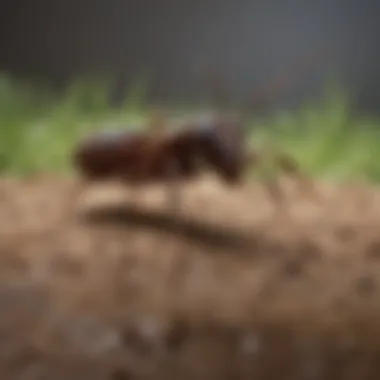

One characteristic of spot treatment is its precision. Homeowners can apply ant killers precisely where they are needed, reducing the risk of exposure to other areas. However, its effectiveness largely depends on proper identification of the nest or active trails.
While spot treatment can be very effective, there are downsides as well. It may not be sufficient for larger infestations that require a broader approach. Therefore, it is important to monitor ant activity after application to determine whether further measures are needed.
Area Treatment
Area treatment involves applying ant killers across a wider space to cover potential infestations. This method is particularly useful in situations where the extent of an infestation is unknown. By treating larger areas, homeowners can ensure that they are not missing hidden nests or trails.
The key characteristic of area treatment is its comprehensive approach, making it a popular choice for those dealing with extensive ant problems. It helps create a barrier that prevents ants from entering treated areas.
However, area treatments can lead to higher product usage, which may raise safety and environmental concerns. It's crucial to choose products that are effective yet safe for use around children and pets. Homeowners should always follow label instructions carefully to avoid any potential risks.
Safety Precautions
When applying ant killers, safety should always be a priority. It is essential to read product labels and follow instructions closely. Using protective gear, like gloves and masks, can help minimize exposure during application. Additionally, keeping children and pets away from treated areas until the product has fully dried is advisable.
Storing chemicals in a safe location away from reach is also critical. Clear labeling and understanding the re-entry intervals for treated areas can further enhance safety.
Proper application techniques and safety precautions are fundamental in effective ant control. Knowing when and how to apply products will yield the best results.
Long-Term Management Strategies
Successful indoor ant control goes beyond immediate eradication efforts. It requires a commitment to long-term management strategies. This aspect is vital for preventing future infestations and reducing the likelihood of recurrence. Implementing these strategies can save time, money, and effort down the line. A proactive approach can also minimize the need for chemical treatments, which is beneficial for both health and the environment.
Regular Monitoring
Regular monitoring is critical in managing indoor ant populations. By observing activity levels and scouting strategically, homeowners can catch issues early. This involves physically checking areas where ants might enter. Typical points of entry include windows, doors, and cracks in the foundation.
Keep an eye out for new trails, especially when seasons change. For example, in spring, ants often become more active as they search for food and nesting sites. It might be helpful to keep a log of sightings, noting locations and times. Such detailed records can inform better decision-making.
When monitoring, look for signs, such as:
- Ant trails leading to food sources
- Nesting locations in warm or damp areas
- Piles of frass or ant waste
Greater awareness helps in managing infestations effectively.
Adjusting Preventive Measures
Adjusting preventive measures is essential as conditions change within the home. The strategies that worked in one season may become ineffective in another. For instance, during fall and winter, ant behavior alters as they seek shelter indoors. This is a crucial period to enhance prevention activities.
Consider reassessing food storage practices. Are any food items left accessible? Make sure that all food is sealed in airtight containers. This can prevent attracting ants in the first place. Additionally, check around the home for any potential moisture issues. Ants are often drawn to damp areas, so repairing leaks should be a priority.
Key Actions for Adjusting Preventive Measures:
- Seal cracks and gaps around windows and doors.
- Maintain cleanliness in food preparation areas.
- Keep landscaping tidy to limit access to your home.
Case Studies and User Experiences
Understanding real-life situations through case studies and user experiences provides valuable insights into the practical application of ant control techniques. This section draws upon numerous homeowner narratives and professional pest control accounts that exemplify effective strategies against various ant infestations. By evaluating these experiences, readers can gain a clearer understanding of what methods are successful and what challenges may arise during ant control efforts.
These accounts not only highlight the importance of tailored solutions based on specific ant species and circumstances but also reinforce the notion that comprehensive preparation is critical. Learning from others helps homeowners save time, reduce frustration, and enhance the efficacy of their pest management practices.
Successful Homeowner Interventions
Homeowners often find themselves navigating the complexities of ant infestations. Successful interventions usually involve a combination of strategic planning and immediate action. One particularly noteworthy case involved a family dealing with an Argentine ant infestation in their kitchen. Upon discovering trails of ants, they initially employed basic cleaning measures. However, these actions did not yield satisfactory results.
They then researched and selected multiple ant baits, focusing on those designed specifically for Argentine ants. After placing the bait stations in identified hotspots, they observed a significant decrease in ant activity within a few days.
"Using targeted bait was a game-changer for us. We never realized how effective they could be when placed correctly."
— A homeowner’s testimonial
This case underlines the pivotal role of proper product selection and placement in successful ant management. Homeowners should take the time to learn about the specific biology and habits of the ant species they are dealing with. This tailored approach can lead to quicker and more effective results.
Pest Control Professional Insights
Pest control professionals bring a wealth of knowledge to the table, offering insights that can be crucial for homeowners facing more severe infestations. One pest control expert shared an experience involving a massive carpenter ant infestation in a multi-story building. The homeowner initially attempted DIY solutions, but the infestation persisted, leading to increased frustration.
In this instance, the professional emphasized the importance of a comprehensive inspection to determine nesting sites. They utilized both chemical treatments and physical barriers. The success of this intervention stemmed from a well-coordinated effort that combined immediate action and long-term strategies.
The professional's key advice to homeowners is to remain vigilant and seek help before conditions escalate. A proactive strategy often leads to more manageable pest control experiences. The insights from these experts demonstrate that while DIY methods can be effective, sometimes the complexity of the situation necessitates professional help. This collaboration can ultimately yield a more sustainable solution.
The End
The conclusion serves as a crucial component of this article. It encapsulates the primary insights discussed throughout the guide about effective interior ant control solutions. A well-structured conclusion helps solidify the reader's understanding and reinforces the recommended practices and products available for ant management. In addition to summarizing key points, it emphasizes the importance of proactive measures to keep indoor spaces ant-free.
Recap of Key Points
In this guide, several essential practices and products were explored to combat interior ant infestations effectively. Key points include:
- Understanding Common Ant Species: Familiarity with common indoor ant species, such as Carpenter Ants and Odorous House Ants, aids in identification and treatment.
- Identifying Infestation Signs: Recognizing ant trails and knowing their hiding spots are vital for effective intervention.
- Preventive Measures: Sealing entry points and maintaining cleanliness plays a significant role in prevention.
- Evaluating Ant Killers: Information regarding chemical and natural ant killers offers insights on selecting the right solutions.
- Application Techniques: Knowing when and how to apply ant control products ensures safety and efficacy.
- Long-Term Strategies: Regular monitoring and adjusting preventive measures aid in sustained control and management.
These elements provide readers with a structured approach to understanding and managing ant infestations in their homes.
Future Trends in Ant Control
Looking ahead, the future of ant control is likely to incorporate innovative technology and sustainable practices. Homeowners are increasingly interested in eco-friendly solutions. As a result, pest control industries are shifting focus toward products that minimize chemicals and leverage natural components. For instance, advancements in biotechnology may yield more effective, targeted treatments against specific ant species while reducing environmental impacts.
Additionally, the integration of smart technology in pest management, such as monitoring systems and aI-driven assessments, may improve the ability to detect and respond to infestations. Embracing these developments could enhance residential pest control efficacy and align with a growing concern for environmentally responsible practices.
In summary, staying informed on future trends will empower readers to take preventive measures in ant control while adapting to emerging solutions.







